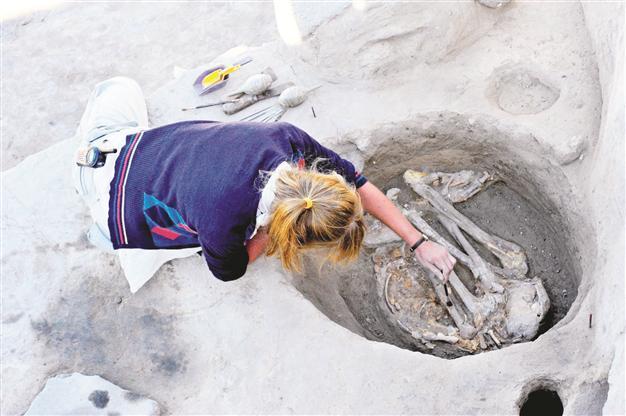Excavations reveal daily life of 10,000 years ago
AKSARAY - Anatolia News Agency

Skeletons (L) found in the Aşıklıhöyük settlement reveal that the approximate average lifespan of people previously living in the area was between 25 and 30 years. AA photos
Excavations in Aşıklıhöyük have reached the bottom layer, revealing information about the first settled life that began there 10,300 years ago. The more than 80 skeletons found in the area show the approximate average lifespan of the people living there then was between 25 and 30 years.The head of the Aşıklıhöyük excavation, Professor Mihriban Özbaşaran, said the area was the earliest-known village settlement in the Central Anatolia and Cappadocia region. Archaeological work in the area began in 1989, and has obtained a great deal of important data that sheds light on both world and Anatolian history. “With a history of 10,300 years, Aşıklıhöyük was the first village in Cappadocia and also a place that led many technological and scientific developments in the world, such as the first agricultural activities and the first brain surgery,” Özbaşaran said.
The 2012 excavation season at Aşıklıhöyük is almost over, she said, adding that this year workers at the site had examined the lifestyle of the people of the area’s first settlement, working on the site’s bottom layer, after digging down for 23 years. “This year we tried to understand the lifestyle of the people who arrived in the region first. We started working in this field in 1989, and over time found that these people had lived in oval-shaped brick houses that were halfway underground. We unearthed three houses in the area this year. There were also large open spaces in the area, and we worked on those in order to understand the daily activities of the people. Among those activities were leather processing and animal slaughter, both of which took place in the open areas.”
Burial traditions
Most of the skeletons found in graves at Aşıklıhöyük belong to women and children, Özbaşaran said. “It is interesting that there was a high number of deaths among children and women. Probably many deaths occurred during birth. Epidemic diseases were also prevalent. We determined that the average age of death was between 25 and 30 in Aşıklıhöyük, which is very young. A man who died between the ages of 45 and 50 had one of the longest lives.”
This year a skeleton was unearthed that had been buried in a nontraditional way, Özbaşaran said. “The dead were usually buried under the houses in the fetal position. But we found a child of six or eight years lying in a furnace, which was very different from the other 80 skeletons we have found. We are investigating whether the child died accidentally. Reports from physical anthropologists will reveal the correct answer.”
Human life at Aşıklıhöyük continued for 800 years, Özbaşaran said. Her team will continue its work excavating the area next year.
















